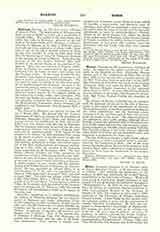

Huanuco, DIOCESE of (HUANUCENSIS), suffragan of Lima in Peru. The department of Huanuco contains an area of 14,027 sq. miles, and a population of 145,309 (1896). The capital of the same name (also called San Leon de Huanuco), situated on the left bank of the upper course of the Huallaga, a tributary entering the Amazon on its right, is 5945 feet above sea-level and has a population of about 7500. Huanuco is one of the oldest Spanish colonies of Peru, having been founded as early as 1539 (four years after the foundation of Lima) by Gomez de Alvarado at the instance of Francisco Pizarro. Soon after the erection of the first houses, however, they were leveled to the ground during an insurrection of the Indians. After the assassination of Pizarro (1541), Pedro de Puelles was empowered by the governor, Cristobal Vaca de Castro, to lead a new colony into the Huallaga valley. In the course of time the city attained a high degree of prosperity, counting at one time, it is said, as many as 70,000 inhabitants. The city owed its rapid rise chiefly to the rich silver mines of the neighboring Cerro de Pasco; the wars of the nineteenth century, however, wrought such ravages that at present it is nothing but a wretched town of scattered houses, relying for its support chiefly on the cultivation of fruits, coffee, and sugar-cane. The city contains besides the cathedral on the Plaza, fourteen churches, including those formerly in charge of the Mercedarians, Dominicans (Santo Domingo, not completed), and Franciscans (San Francisco with a gilded altar).
The Diocese of Huanuco was created by Pius IX on March 17, 1865. He decreed that the (former) department of Junin, consisting of the provinces of Huanuco, Huamalies, Pasco, Tauia, and Tarma, be separated from the Archdiocese of Lima and established as a new diocese, with the seat at Huanuco. The Government undertook to provide for the episcopal mensal revenue, and to erect a diocesan seminary and an episcopal palace. With regard to the chapter to be formed, the Bull stipulated that, owing to the dearth of priests, it should consist of only one dignitary and six canons. Msgr. Sebastiano Goyeniche Darreda, Archbishop of Lima, was named executor of the Bull, which received government ratification on July 5, 1865, the erection of the bishopric being authorized on November 20, 1868. The first bishop, Manuel Teodoro del Valle, presented for nomination on June 5, 1866, was preferred to the Archdiocese of Lima, August 29, 1872, and on November 19 of the same year named titular Archbishop of Berytus, in which capacity he was vested with the administration of his former Diocese of Huanuco (January 11, 1873). He was succeeded by Alfonso Maria de la .Cruz Sardinas, O. F. M—who was appointed on October 31, 1889, preconized August 12, 1890, and died in June, 1902. The third and present (1909) bishop is Msgr. Pedro Pablo Drinot y Pierola of the Congregation of the Sacred Heart (Picpus Society), born at Callao, November 26, 1859, presented by the Government for nomination, February 27, 1904, preconized August 19, and consecrated at Lima on August 24 of the same year.
Statistics.—According to its present delimitation, the Diocese of Huanuco embraces the two departments of Huanuco and Junin, comprising about 37,380 (according to other authorities 41,586) square miles and 539,702 inhabitants, of whom 288,100 are Catholics and the rest for the most part uncivilized Indians. It contains 45 parishes, 210 churches and chapels, and 75 priests. West of the present city of Huanuco is Huanuco Viejo (Old Huanuco), an ancient Inca settlement with the ruins of old Peruvian monuments. These include a temple constructed out of massive square blocks of stone, called El Castillo, a royal palace, and extensive ruins of dwellings, with which are connected a series of singular towers along the slope of the hill, used by the early inhabitants as store or provision-houses. Farther inland on the River Pozuzo, but within the limits of the department of Huanuco, is the German colony of Pozuzo, established in 1859 by Freiherr von Schatz-Holzhausen; it has about 600 Catholics from the Rhineland and the Tyrol, with their own German pastor.
GREGOR REINHOLD

